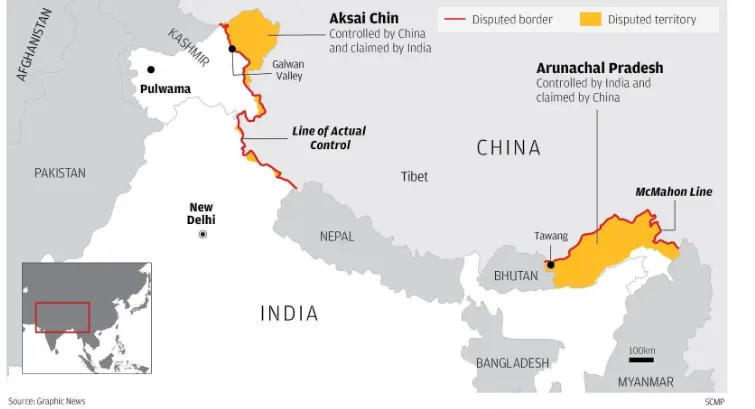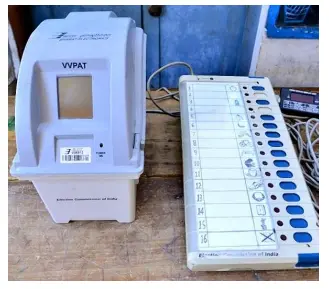Monday, 15th April 2024
Supreme Court's Concern Over Increasing State Appeals Against Centre
In News: Supreme Court recently Expresses Concern Over States' Increasing Need to Approach Against Centre.
Challenges Faced by States Regarding Disbursement of Financial Aids
- Delayed and Insufficient Disaster Relief:
- Lack of coordination between the Centre and states in the disbursement of disaster management funds (NDRF and SDRF).
- Concerns over the Centre's unilateral decision-making in determining the quantum of disaster assistance.
- Lack of clear, transparent, and objective criteria for the Centre to determine the quantum of disaster relief and rehabilitation assistance to states.
- Absence of enough institutionalised mechanisms for states to challenge the Centre's decisions on disaster aid.
- Imbalance in the Centre-State Disaster Management Framework:
- Perceived over-centralisation of disaster management powers and decision-making authority with the Centre.
- Concerns over the NDMA being overly dependent on the Centre and lacking effective representation of states.
- Lack of flexibility for states to customise disaster response and mitigation measures as per their local contexts and priorities.
- Centralised Planning:
- Centralised planning may not always take into account the unique needs and circumstances of each state, leading to inefficiencies in the response to disasters or other situations requiring aid.
- Political Dynamics:
- Political dynamics and relationships between the central government and the states can influence aid distribution, sometimes leading to allegations of bias or favouritism.
- Lack of Consultation:
- The Centre is often accused of not adequately consulting the states while formulating policies and schemes, leading to implementation challenges.
- Instances of the Centre unilaterally imposing decisions on the states without their consent have been a source of friction.
- Lack of effective institutional platforms for regular dialogue and dispute resolution between the Centre and states:
- Weakening of federal spirit and collaborative approach in the face of growing competitive and adversarial politics.
Way Forward
- Enhance fiscal federalism by reviewing taxation powers and revenue sharing, addressing fiscal imbalances.
- Revitalise institutional platforms for regular dialogue and consensus-building between the Centre and states.
- Promote collaborative policymaking and effective dispute resolution mechanisms to address Centre-state conflicts.
- Improve transparency in decision-making for disaster relief funds and aid utilisation.
- Enhance audit and oversight to prevent misappropriation and discrimination.
- Promote a political culture that prioritises national interests over partisan agendas and encourages cooperation and mutual respect between the Centre and state levels.
- Educate citizens about the importance of cooperative federalism for effective governance and equitable growth.
|
UPSC Previous Year Questions Prelims (2017) Q. Which one of the following is not a feature of Indian federalism? (a) There is an independent judiciary in India. (b) Powers have been clearly divided between the Centre and the States. (c) The federating units have been given unequal representation in the Rajya Sabha. (d) It is the result of an agreement among the federating units. Ans: (d) Q2. Local self-government can be best explained as an exercise in (a) Federalism Ans: (b) Mains (2020) Q. Discuss the recent measures initiated in disaster management by the Government of India departing from the earlier reactive approach. Mains (2016) Q. With reference to National Disaster Management Authority (NDMA) guidelines, discuss the measures to be adopted to mitigate the impact of the recent incidents of cloudbursts in many places of Uttarakhand. |
Source: TH
Establishment of a New Army Division with Emphasis on Eastern Ladakh
In News: A longstanding proposal to establish a new Army division, potentially for deployment in eastern Ladakh, may finally come to fruition this year.
Creation of 72 Division
- The Indian Army is considering the establishment of the 72 Division, potentially for deployment in eastern Ladakh under the Northern Command.
- Originally, the 72 Division was intended to operate within the 17 Mountain Strike Corps (MSC) stationed in Panagarh, West Bengal.
- A typical division consists of approximately 14,000 to 15,000 troops.
Restructuring of Army Corps
- Amid the military standoff with China, a restructuring was carried out in 2021, impacting the composition of Army corps.
- Previously, only the 17 MSC was primarily focused on China, while others were oriented towards Pakistan.
- To address the Chinese threat, restructuring was undertaken, allocating two strike corps for mountainous regions facing China.
- The 1 Corps and 17 Corps were restructured to concentrate on the northern and eastern borders, respectively, aimed at addressing Chinese threats.
Role of 1 Corps and 17 Corps
- The role of the 1 Corps shifted to focus on the northern borders with China, with the addition of two infantry divisions.
- The 17 Corps received an extra division from an existing corps to enhance its focus on the eastern theatre.
- Elements of the 17 Corps were deployed in eastern Ladakh amid the military standoff with China.
Part of Two-Pronged Strategy
- The creation of the 72 Division is part of broader redeployment changes planned within the Northern Command.
- This strategy aims to focus on eastern Ladakh amidst the standoff along the Line of Actual Control (LAC) with China.
- Additionally, it aims to ensure there are no gaps in the training of strike corps elements.
Situation Around LAC After Galwan Incident
- Following the deadly clashes in the Galwan Valley in June 2020, both India and China deployed significant troop numbers along the Line of Actual Control (LAC).
- Some friction points, such as the Galwan Valley and parts of the Pangong Tso area, have witnessed partial resolution with the creation of buffer zones.
- However, legacy friction points like Depsang Plains and Demchok have yet to see any disengagement.
Operation Meghdoot
- Operation Meghdoot was a military operation conducted by the Indian Armed Forces on April 13, 1984.
- Its objective was to secure control over the strategically important Siachen Glacier in the eastern Karakoram Range of the Himalayas, located in Kashmir.
- The operation involved airlifting Indian troops to key positions along the glacier to prevent Pakistan from gaining control over the area.
- India's military presence in the Siachen Glacier region has been maintained since the operation, viewed as a bold response to what New Delhi perceives as Pakistan's aggression in the region north of map reference NJ9842.
Source: IE
Timekeeping on the Moon
In News: The European Space Agency has recently announced plans for developing a universal timekeeping system tailored for the moon.
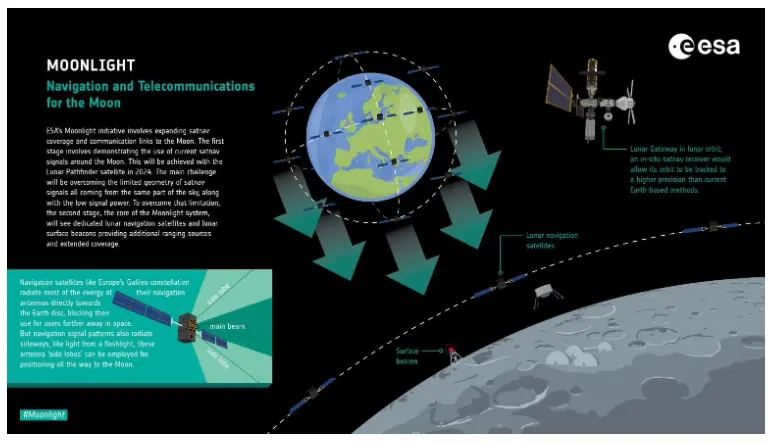
Timekeeping on the Moon
- About
- The Moon, Earth's only natural satellite, follows its own day and night cycle, lasting approximately 29.5 Earth days.
- Presently, time on the Moon is measured using Universal Time Coordination (UTC), the same system used on Earth.
- A new unified time standard called 'Coordinated Lunar Time' (LTC) will be established for the Moon.
- To determine LTC, at least three atomic clocks will need placement on the lunar surface. These clocks will operate at the Moon’s natural pace, with their outputs combined by an algorithm to create a more precise virtual timepiece.
- Need of LTC
- LTC will serve as a timekeeping benchmark for lunar spacecraft and satellites requiring extreme precision.
- It will facilitate synchronized communication among satellites, astronauts, bases, and Earth.
- Due to the Moon's longer day compared to Earth's, using UTC for daily lunar activities would be challenging.
- While the International Space Station continues to utilize coordinated universal time (UTC), the Moon's lesser gravitational force causes time to move 58.7 microseconds faster every day.
- An atomic clock on the Moon will tick at a different rate than one on Earth.
- Proposals have been made to establish a lunar time zone based on the Moon’s day and night cycle to aid lunar settlers in time management and activity coordination.
- Having a lunar time zone would simplify research experiments and data collection on the Moon and reduce confusion and errors stemming from differing timekeeping systems on Earth and the Moon.
- Challenges
- Implementing a unified time standard for the Moon necessitates extensive global cooperation and consensus on the scientific intricacies of timekeeping.
|
UPSC Previous Year Questions Prelims (2008) Q. Selene-1, the lunar orbiter mission belongs to which one of the following? (a) China Ans: (c) Prelims (2008) Q.2 What is the purpose of the US Space Agency’s Themis Mission, which was recently in the news? (a) To study the possibility of life on Mars Ans: (c) Prelims (2009) Q. Which one of the following planets has largest number of natural satellites or moons? (a) Jupiter Ans: (a) Prelims (2015) Q. Tides occur in the oceans and seas due to which among the following?
Select the correct answer using the code given below: (a) 1 only Ans: (d) |
Source: LM
Demographic Transition of India
In News: India's population growth has been a significant concern, with forecasts from the UN Population Division indicating a potential increase to 1.7 billion by 2065. This underscores the ongoing transition of the demographic dividend in India.
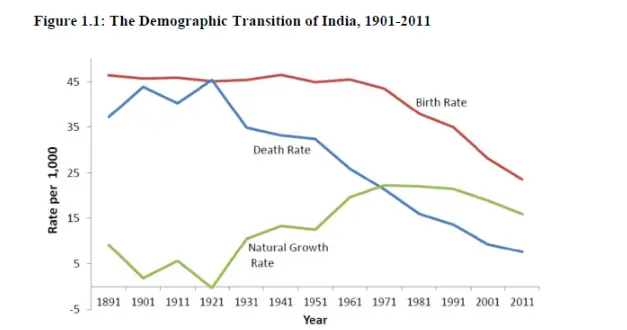
Demographic Transition and Demographic Dividend
Definition and Explanation
- A demographic shift denotes alterations in a population's composition over time, influenced by factors such as birth and death rates, migration patterns, and socio-economic conditions.
- The demographic dividend occurs when a nation's population structure shifts from a high dependency ratio to a higher proportion of working-age adults, potentially fostering economic growth through human capital investment and productive employment opportunities.
Factors Triggering Demographic Transition in India
- Rapid Economic Development:
- India's swift economic progress, especially since the early 21st century, has significantly driven demographic transition by enhancing living standards, healthcare access, and educational opportunities, thereby lowering fertility rates.
- Reduction in Infant and Child Mortality Rates:
- Improved healthcare facilities and reduced child mortality rates have alleviated the necessity for larger families to ensure old-age support, leading to smaller family sizes.
- Rise in Women's Education and Work Participation:
- Increased education and employment among women have contributed to declining fertility rates as financially independent and educated women tend to have fewer children and delay childbirth.
- Improvement in Housing Conditions:
- Enhanced housing conditions and access to basic amenities have positively influenced family planning decisions by improving overall quality of life.
Challenges of Demographic Transition in India
- Dependency Ratio Shift:
- While an initial decline in the total fertility rate (TFR) decreases the dependency ratio, the eventual aging of the population leads to a higher proportion of elderly dependents, straining healthcare and welfare resources.
- Uneven Transition Across States:
- Disparities in fertility rate decline across Indian states, particularly in states like Uttar Pradesh and Bihar, pose challenges in achieving uniform demographic transition, exacerbating regional economic and healthcare disparities.
- Labour Productivity and Economic Growth:
- Managing the aging workforce and ensuring skill development for the younger population presents challenges alongside potential economic growth spurred by demographic transition.
Opportunities of Demographic Transition in India
- Enhanced Labour Productivity:
- Decelerated population growth due to demographic transition can lead to increased capital and infrastructure availability per capita, bolstering labour productivity.
- Reallocation of Resources:
- Reduced fertility rates allow resources to be redirected towards education and skill development, potentially improving human capital and workforce productivity.
- Increased Women Participation in Workforce:
- Declining fertility rates may lead to more women joining the workforce as reduced childcare responsibilities free up time for employment, contributing to greater gender parity in the labour market.
- Spatial Redistribution of Labour:
- Migration of labour from surplus regions to areas with expanding industries can balance the labour market geographically, potentially improving working conditions and mitigating wage discrimination and security concerns.
Way Forward
- Capitalizing on demographic transition opportunities through sectoral and spatial workforce redistribution, skill development, and enhanced women's participation in the workforce can position India as a significant economic player in the 21st century.
- Effective policy formulation addressing healthcare, education, and skill development, with a focus on inclusivity, is imperative to harness India's demographic dividend and foster global economic competitiveness.
|
UPSC Previous Year Questions Prelims (2019) Q. In the context of any country, which one of the following would be considered as part of its social capital? (a) The proportion of literates in the population Ans: (d) Prelims (2011) Q2. India is regarded as a country with “Demographic Dividend”. This is due to (a) Its high population in the age group below 15 years Ans: (b) Mains (2021) Q1. Discuss the main objectives of Population Education and point out the measures to achieve them in India in detail. Mains (2019) Q2. ‘’Empowering women is the key to control the population growth.’’ Discuss. Mains (2015) Q3. Critically examine whether growing population is the cause of poverty or poverty is the main cause of population increase in India. |
Source: IE
The Khavda Renewable Energy Park
In News: Recently, Adani Green Energy Ltd (AGEL) established the world’s largest renewable energy park in Gujarat’s Khavda region.
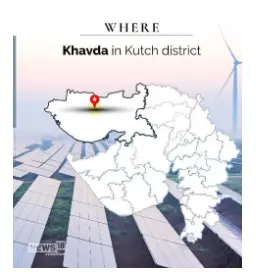
About The Khavda Renewable Energy Park
- The Khavda Renewable Energy Park stands as the world’s largest renewable energy park.
- Located in Gujarat's Kutch region, specifically at Khavda, it boasts an impressive 45 GW capacity, mainly fueled by solar energy.
- The region benefits from the second-best solar radiation in the country, following Ladakh, and wind speeds five times that of the plains.
- Positioned merely one kilometer from the international border with Pakistan, the park maintains a buffer zone manned by the Border Security Force (BSF).
- Originally accessible only by a modest airstrip lacking air traffic control, the site is now being prepared for a significant clean energy venture.
- Spanning 538 square kilometers, it covers an area approximately five times the size of Paris.
- Constructed by Adani Green Energy Ltd (AGEL), India's largest renewable energy company.
- Investment: AGEL is set to invest about Rs 1.5 lakh crore to generate 30 megawatts of clean electricity, consisting of 26 GW of solar and 4 GW of wind capacity.
- At its peak, the Khavda Park is projected to generate 81 billion units of electricity, enough to power entire nations such as Belgium, Chile, and Switzerland.
Source: NEWSX
Kuchipudi
In News: Recently, it has been noted that Kuchipudi artists are facing challenges and enduring a difficult period due to a lack of support and patronage.
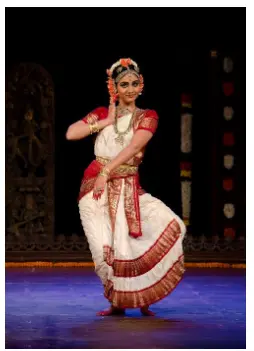
About Kuchipudi
- Kuchipudi is an Indian classical dance form originating from Andhra Pradesh.
- History:
- Originally performed by itinerant actors called Bhagavathalu, who traveled between villages performig plays and dances based on Hindu mythology.
- In the 15th century, Siddhendra Yogi, a renowned poet and musician, played a significant role in its development, elevating it from a folk art to a refined classical dance form.
- Features:
- Characterized by intricate footwork, graceful movements, and subtle facial expressions.
- Combines elements of pure dance (Nritta), expressive dance (Nritya), and storytelling through dance (Natya).
- Often performed on the edge of a brass plate called Tarangam, synchronized with Carnatic music beats.
- Rooted in Vaishnavism tradition, particularly focused on the Hindu god Krishna, and closely associated with Bhagavata Mela.
- Kuchipudi performers require proficiency in Sanskrit, Telugu, music, and manuscripts related to the performance.
- Adorned with light makeup and traditional ornaments like Rakudi (head ornament), Chandra Vanki (arm band), Adda Bhasa, and Kasina Sara (necklace). Hair adorned with flowers and jewelry, and ornaments typically made of light wood called Boorugu.
- Musical accompaniments include instruments like mridangam, cymbals, veena, flute, and tambura.
Source: TH
Impatiens neo-uncinata
In News: Researchers recently identified a new species of garden balsam in Kerala, naming it Impatiens neo-uncinata.
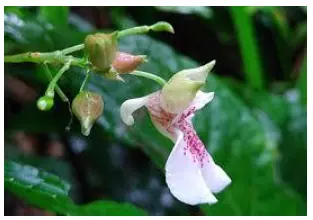
About Impatiens neo-uncinata
- It is a newly discovered species of Impatiens belonging to the family Balsaminaceae.
- Found in the Western Ghats, it is identified as a rare wild relative of the commonly known garden balsam.
- This species has only been observed in a single location, situated at elevations between 1,000 to 1,250 meters, and in limited numbers.
- Morphologically similar to Impatiens uncinata, it differs in various aspects such as flower size, basal and distal lobes, dorsal petal, and pollen.
- Typically a herb growing up to 20 cm tall, with either simple or branched stems, it thrives in open areas within evergreen forests, particularly in wetlands.
- Flowering and fruiting of this species occur from August to December.
- The genus Impatiens comprises over 1000 species found across tropical and sub-tropical regions.
- In India, the Himalayan and north-eastern regions exhibit the highest diversity of Impatiens, followed by the southern arm of the Western Ghats.
Source: TH
Platelets
In News: Researchers have created synthetic platelets capable of halting bleeding and promoting healing at the injury site.
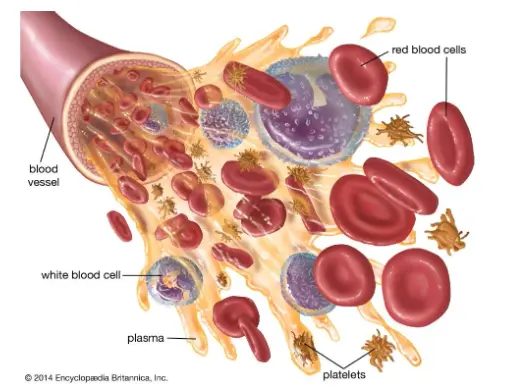
Platelets: Essential Blood Components
- Platelets, also known as thrombocytes, are small, colorless cell fragments found in our blood that aid in clotting, acting as the body's natural bandage to stop bleeding.
- Platelets are produced in the bone marrow, specifically by the largest cells in the bone marrow known as megakaryocytes.
- They derive their name from their plate-like shape and are smaller than both red and white blood cells.
- In the event of blood vessel damage, platelets are activated and rush to the site of injury, forming a plug or clot to repair the damage.
- This process involves adhesion, where platelets spread across the surface of the damaged vessel and stick together, aided by chemical signals that attract more platelets, leading to aggregation.
- A healthy platelet count typically ranges from 150,000 to 450,000 platelets per microliter of blood.
- Thrombocytosis occurs when there are more than 450,000 platelets, while thrombocytopenia is characterized by fewer than 150,000 platelets, which can result in symptoms like easy bruising and excessive bleeding.
- Platelets play a crucial role in surgeries, such as organ transplants, and are vital in combating diseases like cancer, chronic illnesses, and traumatic injuries.
- In cases where individuals have insufficient platelets or platelet dysfunction, donor platelets are transfused to support their clotting function.
Source: ME
Global Forest Watch
In News: According to the most recent data from the Global Forest Watch monitoring project, India has lost 2.33 million hectares of tree cover since 2000.
About Global Forest Watch (GFW)
- GFW is an open-source web application for monitoring global forests in near real-time using satellite data and other sources.
- It is a project of the Washington-based nonprofit research organization, the World Resources Institute (WRI), with most data compiled by University of Maryland researchers.
- The platform is free and user-friendly, allowing users to create custom maps, analyze forest trends, subscribe to alerts, or download data for local areas or the entire world.
Key Points from GFW's Annual Forest Loss Data
- Loss of primary forests in the tropics decreased by 9% compared to 2022, with approximately 37,000 square kilometers lost last year.
- Brazil, the Democratic Republic of Congo, and Bolivia led in tropical countries with the most primary forest losses.
- Global deforestation increased by 3.2% in 2023.
- India lost 2.33 million hectares of tree cover since 2000, with a 6% decrease during this period.
- The country lost 414,000 hectares of humid primary forest from 2002 to 2023, accounting for 18% of total tree cover loss.
- Indian forests emitted 51 million tons of carbon dioxide equivalent annually between 2001 and 2022, with a net carbon sink of 89.9 million tons annually.
- An average of 51.0 million tons of carbon dioxide equivalent per year was released due to tree cover loss in India.
- 95% of tree cover loss in India from 2013 to 2023 occurred within natural forests.
- Five states accounted for 60% of all tree cover losses between 2001 and 2023, with Assam leading in tree cover loss.
Source: NDTV
Financial Services Institutions Bureau
In News: Recently, FSIB put forward the nomination of Manoj Mittal, the Managing Director of IFCI, for the position of Chairman and Managing Director of SIDBI.
Overview of the Financial Services Institutions Bureau (FSIB)
- Establishment:
- FSIB is a government body established under the Department of Financial Services (DFS), Ministry of Finance.
- It serves as a replacement for the Bank Board’s Bureau (BBB), which was deemed incompetent.
- Structure:
- Headed by a chairman, nominated by the central government.
- Board composition includes Secretaries of DFS, chairman of IRDAI, and a deputy governor of RBI.
- Additionally, it comprises three part-time members from banking expertise and three from the insurance sector.
- Functions:
- Recommends candidates for senior positions such as whole-time directors (WTDs) and non-executive chairpersons (NECs) in Public Sector Banks (PSBs), financial institutions (FIs), and Public Sector Insurers (PSIs).
- Advises the government on appointment-related matters, including transfers, extensions, and terminations of director services.
- Issues guidelines for selecting general managers and directors of public sector general insurance companies.
- Provides recommendations on desired management structures, performance appraisal systems, code of conduct enforcement, and training programmes.
- Assists PSBs, FIs, and PSIs in developing business strategies and capital raising plans.
- Conducts processes and draws up panels for consideration by competent authorities for other banks, financial institutions, or insurers upon government reference, in consultation with the relevant regulator.
Source: ET
Is the Effectiveness of Electricity Distribution Franchisees Questionable? It’s Time for a Reality Check
In News: The "Bhiwandi Model" in the late 2000s popularized franchisees for electricity distribution reform, but despite bailout packages like the Financial Restructuring Plan of 2012 and the Revamped Distribution Sector Scheme (RDSS) of 2023 advocating for franchisee implementation to reduce losses, practical experience suggests otherwise.
Distribution Franchisee: Overview and Status
Definition and Structure
- A distribution franchisee is an entity authorized by an electricity distribution company (discom) to handle distribution operations within a designated area, excluding power procurement, while the discom retains responsibility for regulatory compliance.
- The franchisee supplies electricity to the area and pays a predetermined rate per unit of electricity supplied, termed the "input rate," aiming to generate profits by reducing losses below the input rate level.
- This arrangement, known as the Input-Based Distribution Franchisee (IBDF), is widely adopted by discoms across India.
Status of Distribution Franchisees
- As of now, 28 franchisees have been established across nine states, with only 12 operational.
- Operational franchisees include those managed by Torrent Power Ltd, CESC Ltd, FEDCO, Sai Computers, and Tata Power Ltd.
- However, the status of two franchisees in Meghalaya and two in Tripura remains unclear due to a lack of public data availability.
Concerns Related to Discoms
- Data Unavailability:
- Although franchisees claim significant loss reductions in their annual reports, this data is self-reported, lacking independent third-party verification to confirm performance.
- Transparency regarding distribution losses and capital expenditure plans is limited, with only a few franchisees having publicly available third-party audited data.
- Inability to Enforce Contractual Provisions:
- Discoms often fail to enforce contractual terms, such as third-party audits, to protect their financial interests, leading to delays in essential audits and revenue calculations.
- Political Support Dependency:
- Franchisees operating in high-loss areas require political support to combat illegal activities, making contract continuity challenging during political leadership changes.
- Contract Termination Complexity:
- Terminating franchise contracts can be complex and costly, with ongoing arbitral proceedings in Maharashtra and Odisha, potentially resulting in significant financial impact and unpaid dues for discoms.
- Uncertainty Amid Energy Transition
- As the energy landscape shifts towards renewables, discoms face challenges in adapting quickly and cost-effectively to changing consumer behaviors and preferences.
- The Future of Discoms
- Future discoms may focus on providing electricity infrastructure and services to small, rural, and agricultural consumers, necessitating a robust framework for efficient distribution network management and equal access.
- Conclusion
- The distribution franchise model raises concerns regarding its effectiveness and sustainability in improving electricity distribution efficiency, particularly amid evolving energy landscapes.
- Caution and a reassessment of the franchise model's suitability in meeting the evolving demands of the electricity distribution sector are warranted.
Source: TQ
Share the article
Edukemy’s Current Affairs Quiz is published with multiple choice questions for UPSC exams
MCQ
Get Latest Updates on Offers, Event dates, and free Mentorship sessions.

Get in touch with our Expert Academic Counsellors 👋
Frequently Asked Questions
UPSC Daily Current Affairs focuses on learning current events on a daily basis. An aspirant needs to study regular and updated information about current events, news, and relevant topics that are important for UPSC aspirants. It covers national and international affairs, government policies, socio-economic issues, science and technology advancements, and more.
UPSC Daily Current Affairs provides aspirants with a concise and comprehensive overview of the latest happenings and developments across various fields. It helps aspirants stay updated with current affairs and provides them with valuable insights and analysis, which are essential for answering questions in the UPSC examinations. It enhances their knowledge, analytical skills, and ability to connect current affairs with the UPSC syllabus.
UPSC Daily Current Affairs covers a wide range of topics, including politics, economics, science and technology, environment, social issues, governance, international relations, and more. It offers news summaries, in-depth analyses, editorials, opinion pieces, and relevant study materials. It also provides practice questions and quizzes to help aspirants test their understanding of current affairs.
Edukemy's UPSC Daily Current Affairs can be accessed through:
- UPSC Daily Current Affairs can be accessed through Current Affairs tab at the top of the Main Page of Edukemy.
- Edukemy Mobile app: The Daily Current Affairs can also be access through Edukemy Mobile App.
- Social media: Follow Edukemy’s official social media accounts or pages that provide UPSC Daily Current Affairs updates, including Facebook, Twitter, or Telegram channels.

